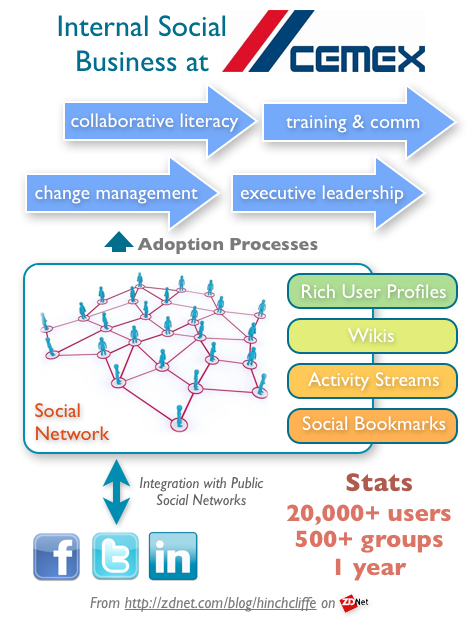Social business success: CEMEX

This is the second in a ten part series -- you can read the overview here -- that takes a detailed look at newer examples of internal social media adoption in the enterprise. Yesterday we took a look at Alcatel-Lucent's efforts. Today we examine the story of CEMEX, the world's largest building materials supplier as well as the third largest cement producer.
CEMEX, a $13.5 billion company (in terms of revenue), initially began in 2009 to develop an internal social network which they subsequently dubbed Shift. Designed as an internal space for workforce collaboration using a blend of consumer social networking concepts and Enterprise 2.0 ideas, Shift is comprised of people connected together with common interests, who create a rich user profile and then collaborate with each other via a standard set of social features including communities, wikis, activity streams, bookmarks, and file sharing. Significantly, Shift also includes widgets that allow employees to connect with their existing social networking platforms, creating a single, common, and integrated social experience for their workers.
CEMEX, which described their work on this internal social business effort in a public white paper, described their mission for Shift as their foray into the "social revolution", which was explicitly:
Designed to innovate and help make the company more efficient and agile by letting employees or groups of employees with similar objectives share opinions, thoughts, information, experience, knowledge and best practices.
The company also laid out three core planks for Shift:
• Encourage wider collaboration among CEMEX's business units and functions. • Create a body of knowledge and experience from all their workers. • Develop new ways to better serve their customers, improve company productivity, and be better situated to meet future challenges.
At the outset of the effort, a detailed assessment of the company’s needs was conducted. The target audience of workers was also examined and analyzed in detail. Though it was a major investment, CEMEX found that this analysis greatly aided in establishing realistic collaboration goals. They also used the findings for platform evaluation and tool selection to ensure that the company's business requirements would ultimately be met.
The process of realizing Shift wasn't always easy or straightforward, something most Enterprise 2.0 practitioners can confirm. The implementation of Shift at CEMEX was a "remarkable experience in terms of the challenges and learning experiences it has presented." The background of the company and composition of its workforce also ended up as significant factors in how Shift was ultimately realized: CEMEX is a company with a long history and like most such companies, it has an entrenched -- and in this case highly traditional -- business culture. The firm also has employees from every age group. In practical terms this means there is a large core audience of workers who are rather new to the concept of social networking. They would have to be engaged effectively if Shift was to succeed.
Various different solutions were considered for these issues. In the end combination of change management processes and proactive efforts to adjust the company's culture to be more collaborative and technology-oriented were developed. Without these, it was clear that participation would likely suffer. The next obstacles soon became obvious; Shift would have to be easy to start using from the outset and would need convincing messaging to go along with the roll-out. The solution that CEMEX used was something that many Enterprise 2.0 efforts often under resource (under the assumption that rollout will follow a viral Facebook growth curve): They provided workers with a self-service help center matched with a string of on-boarding workshops to introduce everyone to Shift. Collaborative literacy skills were also taught in order to teach the skill of working together via social tools. In addition, a wealth of internal communications materials, including posters, teasers, and e-mails, were used to educate and raise awareness of the purpose of Shift.
Careful groundwork and requirements: Rapid adoption
Launched to a beta audience inside the company in January 2010, Shift was released at first only to a handpicked group of testers. Three months later, it was then released across the entire company. It immediately saw a dramatic increase in users. Uptake was rapid enough that within a year from it's initial launch, the company believes that Shift became truly viral. The social collaboration platform reaches over 20,000 users and is now used by 95% of the company’s employees. But adoption doesn't necessarily mean that the platform mission had been accomplished, but the company began to see evidence that the results were paying off. More than 500 communities have been created by users where employees come together to collaborate on subjects that include their specific tasks at hand and communities of practice, developing new processes and improving products, and even important new strategic projects such as CEMEX's Low Carbon Sustainable strategy.From a technology perspective, CEMEX is based on Lotus Connections, which has become one of the "big three" social networking platforms (Jive and SharePoint being the other two), although large enterprises frequently use dozens of different products. However, to me, the most interesting piece of information I came across when researching this case study was the fact that Sergio Escobedo, the innovation director involved in realizing Shift, apparently used executives exclusively as the initial test audience instead of workers. As I've pointed out in my social business adoption research, executive leadership is critical in triggering early adoption. In my opinion, this then largely explains the unusually fast and complete adoption rate that CEMEX experienced at shift (I've seen companies only get to 30% adoption after 5 years, for example, which is still quite good.)
The only thing seemingly missing from the CEMEX story is how much the important capability of community management played in the rapid success of Shift. If/when I receive this information I'll update this post.
Up Next: Burberry.
Don’t miss a single success story. Subscribe to my blog and I’ll keep you updated with the latest case studies.
Other case studies:
